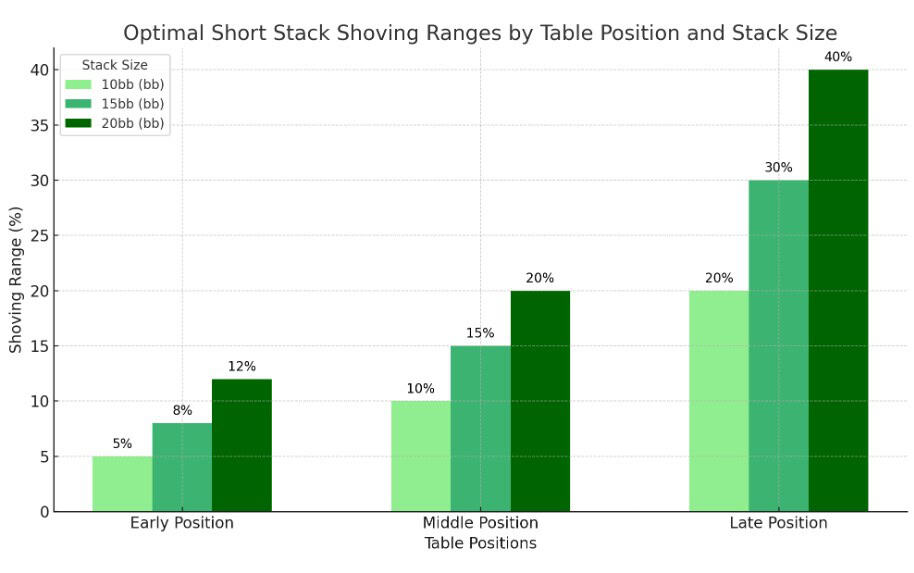
Can short stack poker strategy lead to consistent wins?
Poker is a game of skill, psychology, and strategic maneuvering. While many players prefer to play deep-stacked, there does exist a certain caste of player that does better with limited resources: the short stacker. These players will enter games with meager chip stacks, which simply forces them into an aggressive, high-risk, high-reward playstyle.
But will this strategy bring constant wins? In this article, we shall see what a short stack strategy is, its strong and weak sides, and how you can adapt it to benefit most in the game of poker.
What is a short stack strategy?
In poker, short-stacking refers to playing with fewer than average chips, as in the case of 10 to 30 bb. It’s one of the newest methods occurring in cash games and tournaments, where players buy in at the lowest permissible purchase or lose a huge amount of chips before resorting to such tactics.
Based on this very basic principle – push or fold – players of shallow stacks must go all-in, or fold. That way, it puts maximum pressure and usually will put an opponent into a very difficult decision – go all-in or fold.
Why the short stack strategy?
Short-stacking isn’t entirely about survival; it’s a means to apply mathematical advantages, playing behind. Many players use the following approach for a reason:
- Simplicity and reduced confusion
Simplest decision-making process: Not often in situations that may require complex multi-street bluffs or subtle reads, it’s a poker where much of the emphasis is on aggressive playing early, especially at the preflop and flop stage.
- Max fold equity
That’s because when short-stacked, your opponents realize you can shove all-in at any moment. This builds fold equity and helps you win pots uncontested with an aggressive pre-flop shove.
- Events pay less vari, more reward.
A short stack in tournaments will most likely only prolong your life. Using a few well-timed all-ins, you’ll be able to steal blinds and antes while sticking around in the tournament until you get that fortunate double-up.
- Non-witted opponents to play against
Many casual players struggle against short stackers, underestimating their aggressive shoving ranges. This can lead to costly mistakes, especially in online games where opponents often multitask.
The Secret Ingredients of the Short Stack Strategy

This will require a plan-based aggressive playing style. There are a few central principles by which a short stacker will live or die:
- Choose starting hand
Short stackers have to be very picky about their starting hands. You can’t play those speculative hands the way you would deep-stacked, like suited connectors or small pairs. Stick to:
- High – value pairs: AA, KK, QQ
- Good broadway cards: AK AQ KQ
- High pocket pairs: TT, JJ
- Position Is Everything
Position becomes even more critical when you’re short-stacked. Late-position shoves let you steal the blinds much more effectively as fewer players are left to act. Try not to get trapped in early position unless you have a monster hand.
- Aggressive Pre-flop raise
You will also need to learn your shove ranges, based on a decision concerning when to shove all in and when to fold, taking into consideration chip stack size, table dynamics, and the playing patterns of your opponents. The refinements can be made with push-fold charts or poker calculators.
- Post-flop play (when necessary)
This course is on preflop strategy; a number of flops are shown. Hero will just call first and then view board development, after which he is going to shove or fold depending on the board texture and remaining stack size.
| Position | Stack Size (bb) | Recommended Hands |
|---|---|---|
| Early Position (EP) | <10bb | AA, KK, QQ, AKs |
| Early Position (EP) | 10-15bb | AA, KK, QQ, JJ, AKs, AQs |
| Early Position (EP) | 15-20bb | AA, KK, QQ, JJ, TT, AK, AQ, KQs |
| Middle Position (MP) | <10bb | AA, KK, QQ, JJ, AK, AQ, TT |
| Middle Position (MP) | 10-15bb | AA, KK, QQ, JJ, TT, AK, AQ, AJs, KQs |
| Middle Position (MP) | 15-20bb | AA, KK, QQ, JJ, TT, AK, AQ, KQs, AJs, ATs, 99-88 |
| Late Position (LP) | <10bb | AA, KK, QQ, JJ, AK, AQ, AJs, KQs, TT, 99 |
| Late Position (LP) | 10-15bb | AA-88, AK, AQ, AJ, KQ, KJs, QJs, A8s+ |
| Late Position (LP) | 15-20bb | AA-77, AK, AQ, A9s+, KTs+, QTs+, JTs, suited connectors 76s+ |
| Small Blind (SB) | <10bb | Any Ace (Ax), Kx suited, 55+, suited connectors |
| Small Blind (SB) | 10-15bb | Any pair, Ax, KQ, KJs, broadway hands, suited connectors |
| Small Blind (SB) | 15-20bb | Wider range, including weaker Ax and lower broadway combinations |
| Big Blind (BB) | <10bb | Any Ace, any pair, suited broadways (KJs+), 98s+ |
| Big Blind (BB) | 10-15bb | Any pair, Ax, KQ, KJs, QJs, suited connectors like 87s+ |
| Big Blind (BB) | 15-20bb | Suited broadways, all pocket pairs, Ax hands, suited connectors like 65s+ |
Top errors made by short stackers
In theory, short-stacking is easy; it is hard in practice. Most beginners make the following costly mistakes:
- Overplaying marginal hands
Low-stakes players do a lot of overplaying of many hands like QJ or small pairs, forgetting that short-stacking really wants to be in with the premium hands.
- Table dynamics ignored.
Not paying attention to the size of the opponents’ stacks and style of play, never jamming into big stacks that will have an easy call, or to tight players who never fold.
- Too passive play
Some short-stackers get too tight, waiting forever to get premium hands. They get blinded out and hence get eliminated in the tournament.
- Insert missing value
Many players completely miss optimal shove spots. As a player gets below 10bb, every playable hand becomes a valid candidate for a shove as blind pressure increases.
Strategically transitioning from tournaments to cash games
Short-stacking is the same in both formats, but cash games and tournaments do call for strategically different plays.
Tournaments:
- Survival first: All tourneys are about survival. Play always tight-aggressive early and loosen up near the bubble or final table.
- ICM considerations: Look at payout jumps in relation to principles of Independent Chip Model and thus adjust the shoving range.
Cash games:
- Aggressive frequently: Playing tight-aggressive, mathematical with a main focus on +EV shove.
- Bankroll management: Proper bankroll management needs to be seen, due to the fact that variance is going to come one way or another in cash games.
When Short Stacking Works Best
The short stack strategy shines in certain scenarios:
- Late-stage tournaments: Short stacked players become forced to double or blind out.
- Turbo games: Fast structures make players compress in a lot of ways and favor the short stacker.
- Unpredictable tables: Mash the weak with aggressive shoves, especially when opponents are highly aggressive.
Can short stackers win frequently?

Short answer: Yes, but in the right situations. Dan Harrington and Chris Ferguson famously rode the short-stack strategy to victories in big tournaments. And it will work only with:
- Skill and discipline: Study push/fold charts, follow the tendencies of your opponents, and avoid emotional plays.
- Bankroll management: Anticipate variance; build in the swings.
- Game selection: It is for games where the strategy of short-stacking is in place. These include fast-structured tournaments and low-stakes online cash games.
Conclusion: Is a short stack strategy right for you?
In reality, the short stack strategy isn’t all about survival; it is actually an armory with potent ammunition if wielded properly. Though labelled ‘last resort’ by some, many pros would actually flourish on the same aggressive short-stacking principles.
Whether it’s grinding online tournaments or playing those gut-wrenching live games, knowing how and when to apply this strategy will take your poker game to the next level. Remember: in poker, it’s not the size of your stack, it’s how you play it.
